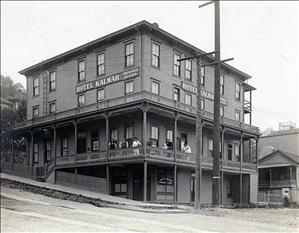This file contains Seattle historian and photographer Paul Dorpat's Now & Then photographs and reflections on the Kalmar Hotel which once stood in Seattle at 6th Avenue and James Street.
Hotel Kalmar
In l962, University of Washington architect Victor Steinbrueck published his sketchbook (now a local classic), Seattle Cityscape. One of its lovingly rendered pen-&-ink drawings was of the Hotel Kalmar, built in 1881 at 6th Avenue and James Street. Steinbrueck's caption tells us that it is the "only remaining [Seattle] example of an early pioneer hotel. ... With its pumpkin-colored wooden siding and band-sawn details, it has been a picturesque part of Seattle's personality. ... much of Seattle's history has been viewed from its wide veranda, but now it is being destroyed to make room for the freeway."
The Kalmar was razed in April 1962.
For more than 70 years, Kalmar guests heard the clanging struggle of the James Street cable cars as they gripped their way up and down the steep side of First Hill. Leonard Brand, the last manager of the Kalmar along with his sister Viola, grew positively fond of that noise. "That clang and clatter didn't bother me at all. Now and again, though, and very often in the middle of the night, they'd shut down the line for repairs. The quiet would wake me right out of a deep sleep."
Actually, he'd never known anything else. He was but three months old when his parents bought the house and renamed it after his mother's hometown in Sweden.
The Kalmar was a workingman's hotel -- when there was work. Many guests were Scandinavian loggers attracted, no doubt, by the name. They were ordinarily sober bachelors who sent their money home. The Kalmar was their home away from home.
In l955, the Kalmar's fate was prescribed when the path of the proposed (Interstate 5) freeway, then called the "Seattle tollway," was drawn through it. Since the freeway, that grandest materialization of progress, could not be moved, local preservationists tried to freeze the Kalmar, promoting a city-wide policy that would prevent the "removal, alteration or remodeling of historical properties without the city council's approval."
In l960, responding to the imminent destruction of the Kalmar and three other historical landmarks, Steinbrueck reflected, "To let them be destroyed is esthetic idiocy on the part of the city. It would be like the case of an idiot who lives only in the present and has no memory of the past. ... Things which have associations and give us a sense of memory are part of our city."
Steinbrueck lamented, "When I go back now to many of these places, nothing is left ... I have only my pictures." Of course, both the attempts to freeze and later to move the Kalmar failed. And now we too are left with only the pictures.

